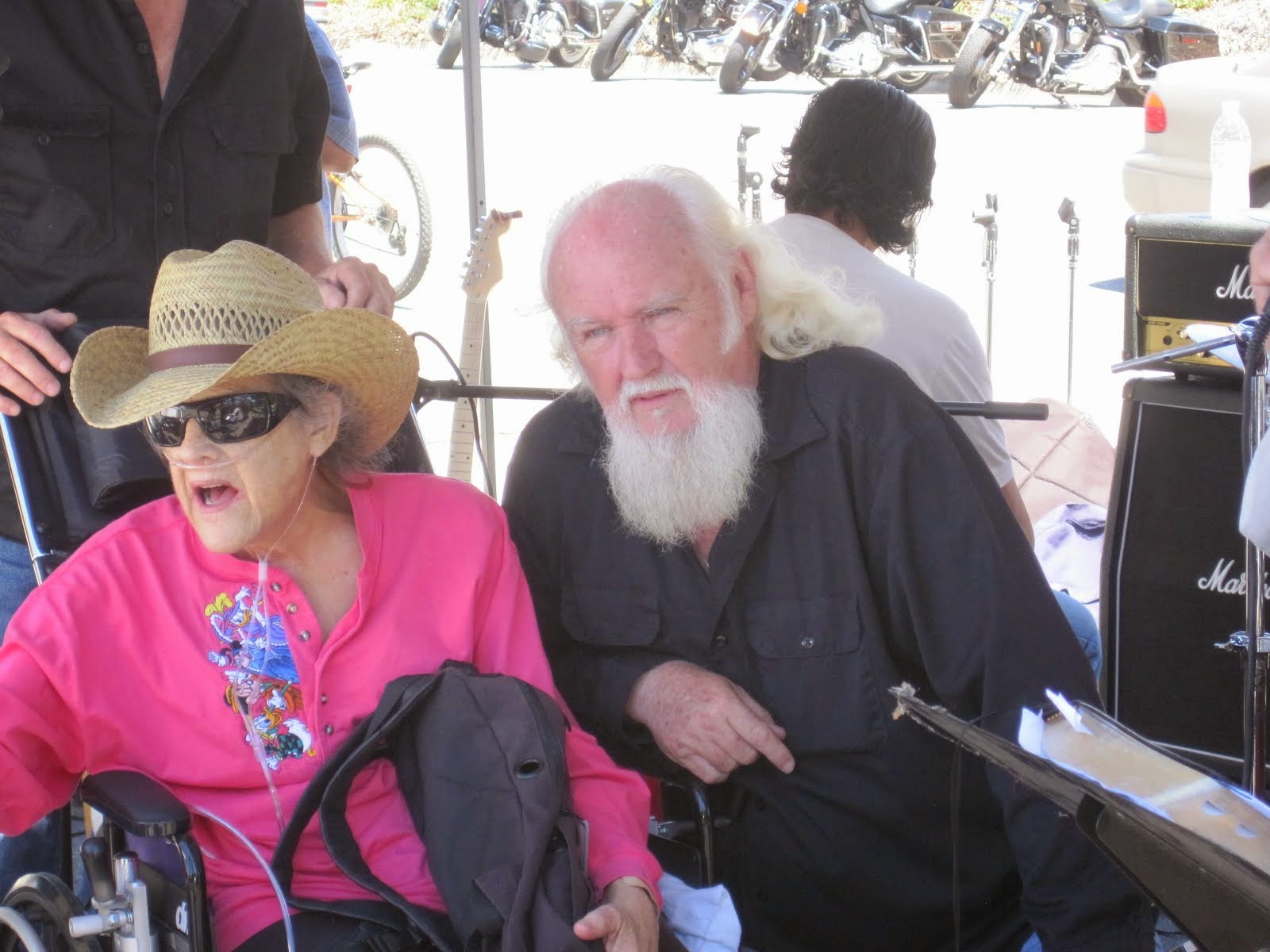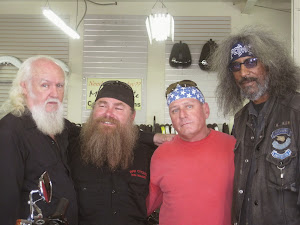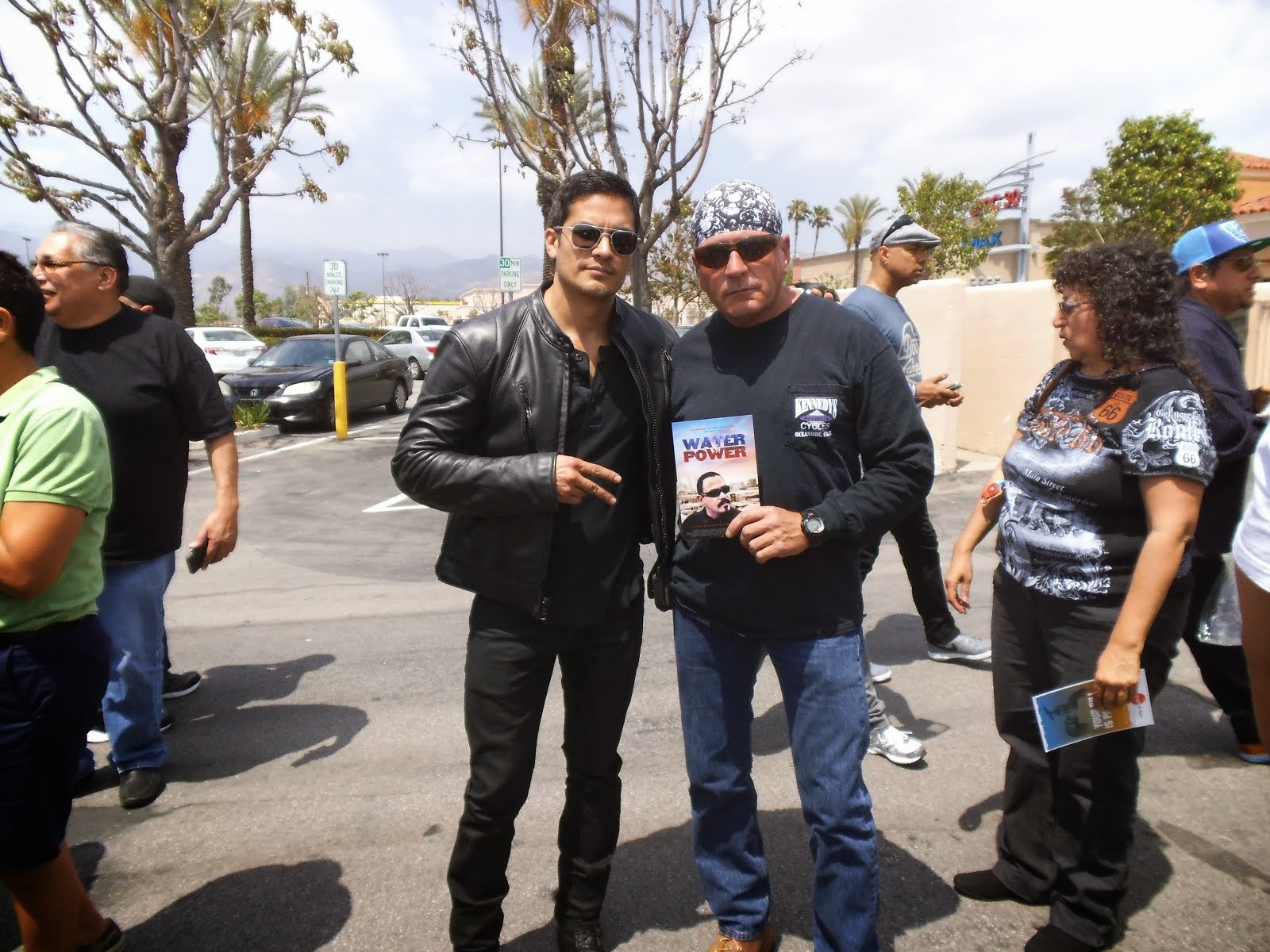OFF THE WIRE,
WRITTEN BY SOMEONE WHO DOES`NT RIDE, SAFETY NANNY
By Foon Rhee, Associate editor
frhee@sacbee.com
Boston's reputation for horrible traffic and terrible drivers is richly deserved. In my five-plus years living there, I never got used to the unwritten rule of not yielding when making left turns. If traffic lights in Boston were timed as closely as they are in Sacramento, it would be a demolition derby at every intersection.
While I find driving in California far less stressful, there's one part that confuses and scares me – motorcycles going in between lanes of congested freeways. More than once, heading down Interstate 80 to the Bay Area, I've nearly collided with lane splitting cycles.
California remains the only state where lane splitting is officially permitted, but the practice is in a peculiar legal purgatory. It is not specifically allowed under state law, but there are no rules banning it, either.
Even state government appears conflicted.
The Department of Motor Vehicles' official motorcycle handbook says lane splitting "is not safe" because "cars and motorcycles each need a full lane to operate safely."
But the official line from the state Highway Patrol is that lane splitting "while not encouraged, is permissible if done in a safe and prudent manner" – interpreted to mean not going more than 10 mph faster than slower cars.
The justification for lane splitting is that it improves traffic flow and helps protect motorcyclists from being rear-ended. But common sense tells me it can't be that safe.
This isn't just idle griping by a newcomer.
While traffic deaths overall have dropped to the lowest on record, going back more than a half century, there's one glaring exception: The number of motorcyclists killed has more than doubled over the past decade or so, in California and in the nation, to all-time highs.
In California, there was a 21-year low with 204 fatalities in 1998. There were an astounding 537 in 2008, the most recent figures available. They accounted for 16 percent of all traffic fatalities, up from 6 percent in 1998. Nationally, the death toll in 2008 reached 5,290 – 14 percent of all traffic fatalities.
Year after year, California is in the top three states for motorcycle fatalities. The others, Florida and Texas, are populous states that allow motorcyclists 21 and older to ride without helmets, unlike California, where helmets have been mandatory since 1992.
While there are no statistics on deaths linked to lane splitting, it is under examination as safety officials and researchers try to figure out why motorcycle fatalities are so much more frequent – and how to reverse the deadly trend.
There are some clear causes. Many more motorcycles are on the road; California registrations, for instance, nearly doubled from 450,000 in 2000 to 824,000 in 2008. Also, motorcyclists are older, with slower reaction times; the typical owner nationally is now 43, compared with 24 in 1980.
Still, motorcyclists account for a disproportionate share of traffic fatalities, and they are about 37 times more likely to be killed than those traveling in passenger cars.
In California, motorcycle safety is one of 16 focus areas for DMV, CHP and nearly 80 other public and private agencies working on a strategic highway safety plan. At a CHP-hosted summit in May 2008, lane splitting was identified as an issue. Those involved in the safety plan are continuing to look at lane splitting, but haven't reached a consensus on what to do.
At the very least, they ought to clarify the law so everyone knows the rules of the road.
Cycle deaths offset seat belts
Federal officials are also concerned by the rise in motorcycle deaths. The U.S. Department of Transportation in October 2007 said that the rise in motorcycle fatalities had "for all practical purposes offset the gain in lives saved resulting from higher seat belt use and improved passenger vehicle safety" and called the issue the nation's "greatest highway traffic safety challenge."
The same month, the National Transportation Safety Board urged federal highway officials to make motorcycle safety a higher priority; among its recommendations, the board called for more study, including on lane splitting.
The Federal Highway Administration has put up $2.4 million for the first major U.S. study since 1981 on the causes of motorcycle crashes. Of the nine possible sites where the research will be conducted, three are in Southern California.
Samir Ahmed, who is leading the research team at Oklahoma State University that is heading up the study, said lane splitting will be looked at. He wasn't willing to offer his opinion of how dangerous it is, saying he would "let the data speak for itself." Those results won't be released until at least 2014, but the study is already hitting speed bumps.
Funding problems forced it to be slashed from 900 crashes to 300, raising doubts about how good the data will be. And before any results, the study is being attacked by some motorcyclist groups who fear it will be used to impose more restrictions on riders.
The most comprehensive review of the available research came out in June from the Oregon Department of Transportation. It concluded that lane splitting could reduce certain kinds of motorcycle crashes and cut overall traffic congestion, but also makes cyclists vulnerable to getting sideswiped by cars.
"Lane sharing presents unique safety considerations due to the fact that motorcycles are allowed in spaces not designed for such traffic and where movement is not expected," the study says. And the risk is higher during congested conditions – precisely when lane splitting is most common.
Lane splitting is called a skill
Even motorcyclists, themselves, are somewhat divided on the issue.
Dave Migliore, who rides with the Capital City Motorcycle Club in Sacramento, says he only lane splits on freeways if traffic is completely stopped, and immediately gets back in lane once cars start moving again. While some motorists give more space as he weaves between cars, others try to block him.
"Riding a motorcycle, you have to be hyperaware," he says. "When lane splitting, it's hyperaware on steroids."
Migliore, 57, who started riding again in 2004 after an 18-year hiatus following a scary spill, commutes on his cycle from downtown Sacramento to his job at Intel in Folsom and cruises on weekends.
"Lane splitting is an acquired skill," he adds. "By its very definition, there are going to be close calls."
But Blake Anderson, chairman of the Southern California Motorcycling Association, says he and his friends and most experienced riders lane split regularly. He says it's safer in stop-and-go traffic than staying in between cars.
"You can get sandwiched," says Anderson, who has been riding for 16 years and whose 600-member club is one of the largest in the region.
He says there are much more dangerous situations, like drivers who turn left in front of him. "Lane splitting is the least of my worries," he says.
Still, he supports clarifying the law, if only to limit the anger he occasionally faces from motorists.
AAA of Northern California, while monitoring the rise in motorcycle deaths, is not pushing legislation, other than opposing any bid to repeal the 1992 helmet law.
Paula LaBrie, the motor club's legislative counsel, is where a lot of people are on lane splitting. While she's heard stories of close calls, she isn't sure it's a major cause of wrecks.
"Is there a real problem there, or is there a perceived problem?" she asks.If state officials can come up with the right answer, and respond accordingly, they could make California's highways safer and save lives.
skip to main |
skip to sidebar




Bill & Annie

Art Hall & Rusty


NUFF SAID.......


































































OOHRAH

ONCE A MARINE,ALWAYS A MARINE

GIVING BACK


MOUNT SOLEDAD














BIKINI BIKE WASH AT SWEETWATER










FRIENDS





BILL,WILLIE G, PHILIP










GOOD FRIENDS


hanging out

brothers


GOOD FRIENDS

Good Friends

Hanging Out




Bill & Annie
Art Hall & Rusty
Art Hall & Rusty


NUFF SAID.......



















NUFF SAID......



























Mount Soledad




BALBOA NAVAL HOSPITAL
RUSTY DANNY

ANNIE KO PHILIP

PHILIP & ANNIE

OUT & ABOUT

OOHRAH...

OOHRAH
ONCE A MARINE,ALWAYS A MARINE

ONCE A MARINE,ALWAYS A MARINE
American Soldier Network GIVING BACK

GIVING BACK
CATHY & BILL
PHILIP & DANNY & BILL

MOUNT SOLEDAD
bills today
EMILIO & PHILIP
WATER & POWER
WATER & POWER
bootride2013



BIKINI BIKE WASH AT SWEETWATER







ILLUSION OPEN HOUSE

FRIENDS


GOOD FRIENDS



BILL,WILLIE G, PHILIP









GOOD FRIENDS

GOOD FRIENDS
Friends
- http://www.ehlinelaw.com/losangeles-motorcycleaccidentattorneys/
- Scotty westcoast-tbars.com
- Ashby C. Sorensen
- americansoldiernetwork.org
- blogtalkradio.com/hermis-live
- davidlabrava.com
- emiliorivera.com/
- http://kandymankustompaint.com
- http://pipelinept.com/
- http://womenmotorcyclist.com
- http://www.ehlinelaw.com
- https://ammo.com/
- SAN DIEGO CUSTOMS
- www.biggshd.com
- www.bighousecrew.net
- www.bikersinformationguide.com
- www.boltofca.org
- www.boltusa.org
- www.espinozasleather.com
- www.illusionmotorcycles.com
- www.kennedyscollateral.com
- www.kennedyscustomcycles.com
- www.listerinsurance.com
- www.sweetwaterharley.com

Hanging out

hanging out
Good Friends

brothers
GOOD FRIENDS

EMILIO & SCREWDRIVER

GOOD FRIENDS
Danny Trejo & Screwdriver

Good Friends
Navigation
Welcome to Bikers of America, Know Your Rights!
“THE BIKERS OF AMERICA, THE PHIL and BILL SHOW”,
A HARDCORE BIKER RIGHTS SHOW THAT HITS LIKE A BORED AND STROKED BIG TWIN!
ON LIVE TUESDAY'S & THURDAY'S AT 6 PM P.S.T.
9 PM E.S.T.
CATCH LIVE AND ARCHIVED SHOWS
FREE OF CHARGE AT...
BlogTalkRadio.com/BikersOfAmerica.
Two ways to listen on Tuesday & Thursday
1. Call in number - (347) 826-7753 ...
Listen live right from your phone!
2. Stream us live on your computer: http://www.blogtalkradio.com/bikersofamerica.
A HARDCORE BIKER RIGHTS SHOW THAT HITS LIKE A BORED AND STROKED BIG TWIN!
ON LIVE TUESDAY'S & THURDAY'S AT 6 PM P.S.T.
9 PM E.S.T.
CATCH LIVE AND ARCHIVED SHOWS
FREE OF CHARGE AT...
BlogTalkRadio.com/BikersOfAmerica.
Two ways to listen on Tuesday & Thursday
1. Call in number - (347) 826-7753 ...
Listen live right from your phone!
2. Stream us live on your computer: http://www.blogtalkradio.com/bikersofamerica.
Good Times
Hanging Out

Key Words
- about (3)
- contact (1)
- TENNESSEE AND THUNDER ON THE MOUNTAIN (1)
- thinking (1)
- upcoming shows (2)
Blog Archive
-
▼
2010
(4242)
-
▼
December
(595)
- No title
- Canada - TRURO - Startling developments in decade-...
- LOCALS FORGE LAW TO FIGHT MOTORCYCLE THEFT
- DUI - Do you feel your state DUI laws are too stiff?
- Policing the police: No oversight - 2nd Installmen...
- With ‘Sovereign Citizen’ Movement Growing, New SPL...
- UPCOMING EVENTS
- Two indicted on gang-related charges
- FUCK YOU ! Neither 'good' nor 'bad,' fatal police ...
- Fiber Optic Mohawk Helmets. Not For Me. For You?
- CA: Drivers Angered by Freeway Campaign Promoting ...
- JUSTICE DENIED FOR A DISABLED VIETNAM ERA VETERAN ...
- National Police Misconduct NewsFeed Daily Recap 12...
- Canada - Whynott to make court appearance this aft...
- Georgia - Biker babes aid troops, charity
- Scott City, MO - Boot-Heel Harley-Davidson Gives T...
- Australia - Sydney tattoo parlour firebombed
- Australia -Sad loss of a charitable man
- Maine AG: ATF agents justified in shooting biker.....
- California - New state law aims to curb motorcycle...
- Missouri - Patriot Guard bikers proud to block Wes...
- Pro-Gun Argument . . .
- CALIFORNIA - New Motorcycle Law Revs Up Controvers...
- F.Y.I. - FREEDOM OF INFORMATION ACT.......
- Australia - Rival bikie gangs up the ante - Coman...
- National Police Misconduct NewsFeed Daily Recap 12...
- WASHINGTON - DEA transformed into global intellige...
- PROJECT - " NOT GIULTY "
- Happy New Year and Mark Your Calendars for the 201...
- A Premature Alarm Regarding Police Fatality Rates
- FABIAN v. FULMER HELMETS, INC.
- House Checks?
- PROJECT - " NOT GIULTY "
- UNITED STATES - Feds To Require Gun Sale Notificat...
- HARLEY RIM FAILURE!
- Arizona - KINGMAN - 7 alleged Vagos indicted
- The FCC's Threat to Internet Freedom
- 2010 Motorcycle Helmet laws a federal issue again???
- New state laws change rules on drinking, handgun a...
- Scientific Research,Study: Fellatio may significan...
- Back-seat Driver: California toughens motorcycle l...
- ATTIKA7
- New legislation that could potentially affect MC p...
- “THE BIKERS OF AMERICA - THE PHIL AND BILL SHOW”
- California - Santa Clara cop now faces federal cha...
- BOLT of Iraq???
- Last Night's Activism
- Germany - Hells Angels on the rise
- ~ Living Legends ~ Lithograph & Book Signing
- LINKS TO SHARE:
- FABIAN v. FULMER HELMETS, INC.
- U.S. - Monitoring America - "See Something, Say S...
- TENNESSEE: Appeals court orders reconsideration of...
- Pittsburgh officer charged in fatal Sept. crash
- KENTUCKY: This years Ride for Freedom 2011 will be...
- VETERANS BENEFITS ACT OF 2010 SIGNED INTO LAW.
- January 8, 2011 Los Angeles, CA Easyriders Bike Sh...
- More rights stolen!! Now it's the internet!! Thank...
- Washington DC - House to read Constitution - 'We t...
- Fourth Amendment Rights
- Federal helmet recommendation could affect motorcy...
- Motorcycle Helmet laws a federal issue again???
- Off-duty San Diego police officer shoots suspect t...
- New legislation that could potentially affect MC p...
- MEMPHIS, Tenn. (AP) — An appeals court has ruled t...
- Cops' Use of Illegal Steroids a 'Big Problem'
- California Gun Laws: APPEAL FILED IN LAWSUIT CHALL...
- “HERMIS LIVE!”-INTERNET RADIO SHOW-BIKERS: MODERN ...
- OUT OF CONTROL - Cheektowaga, NY - Use of Taser br...
- Winter Motorcycle Tire Tips From Dunlop
- Oklahoma - Police corruption probe to deepen in 2011
- Harley-Davidson, Inc. to report fourth quarter ear...
- UPDATE - Top stories of 2010
- Cyprus - Bikie paymaster faces extradition
- UPDATE - Outlaw bikers convicted in RICO case
- UPDATE - Sex trafficking victims at massage parlor...
- A massage parlor eviction incident in Irvine, CA r...
- HPD Officer Probed in Pill Mill
- Georgetown man says police officer kicked him, bro...
- Pocono, PA - Angels in leather embody spirit of Ch...
- Australia - Rebels bikie citadel up for sale
- California - Former Bell Cop Gets Nine Years in Pr...
- Australia - Christmas party like no other..........
- Australia - Top fugitive nabbed in Cyprus
- National Police Misconduct NewsFeed Daily Recap 12...
- AMA ACTION ALERT - New Omnibus Public Lands Bill i...
- Australia - Bikie sign a hoax: owners
- IMPORTANT NEWS - CNN Breaking News House OKs measu...
- Australia - Gunman 'was taking shots at strip club'
- New rules may result in no fireworks
- INTERNATIONAL NEWS: Jamaica - Police get motorcyc...
- Biker/Santa inspires Club to Hold Toy Drive....
- IOWA: Motorcycle helmets should be required by law
- Australia - Alleged biker bans himself from pubs
- Outlaws Motorcycle Gang Members Found Guilty
- New York - Celebration to recall life of Fran Zygl...
- CHARLESTON, W.Va. - Former prison guard sentenced ...
- CHARLESTON, W.Va - Man who sold cocaine to Pagans ...
- INTERNATIONAL NEWS: Jerusalem - Avi Cohen's injury...
- Illinois - CHICAGO - 'Large Guy' convicted in Chic...
-
▼
December
(595)
Bikers of America, Know Your Rights!... Brought to you by Phil and Bill
Philip, a.k.a Screwdriver, is a proud member of Bikers of Lesser Tolerance, and the Left Coast Rep
of B.A.D (Bikers Against Discrimination) along with Bill is a biker rights activist and also a B.A.D Rep, as well, owner of Kennedy's Custom Cycles
